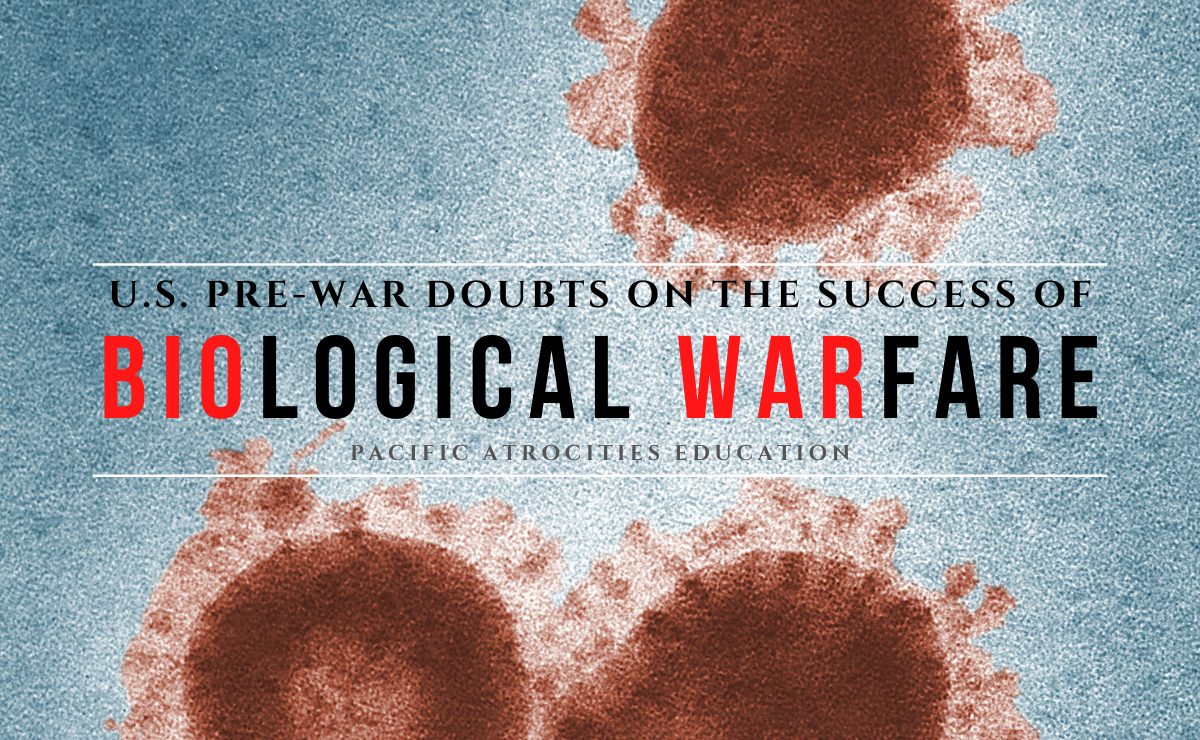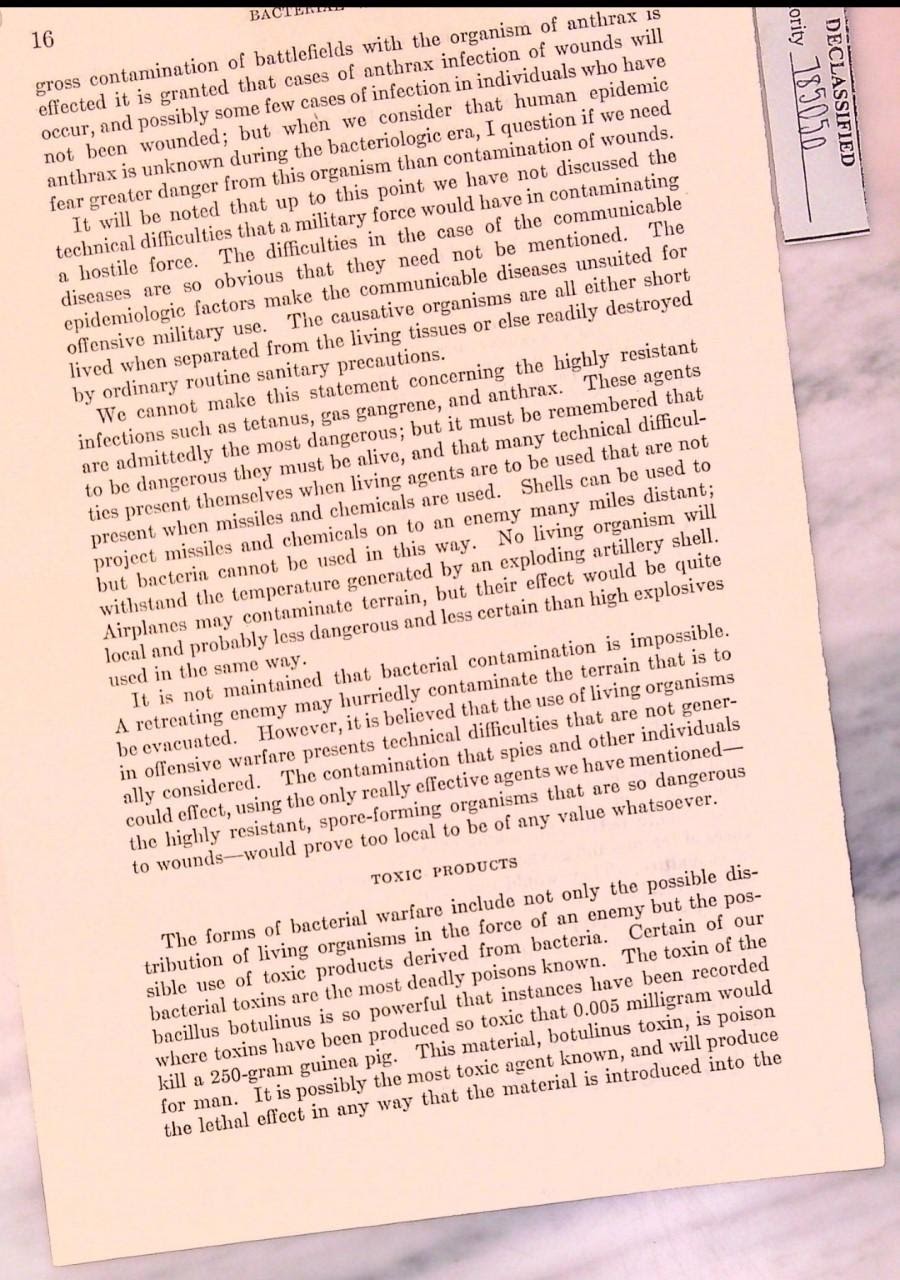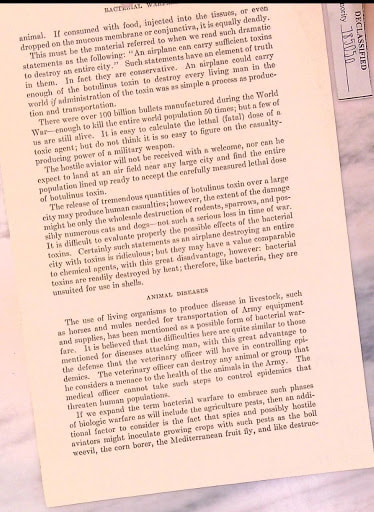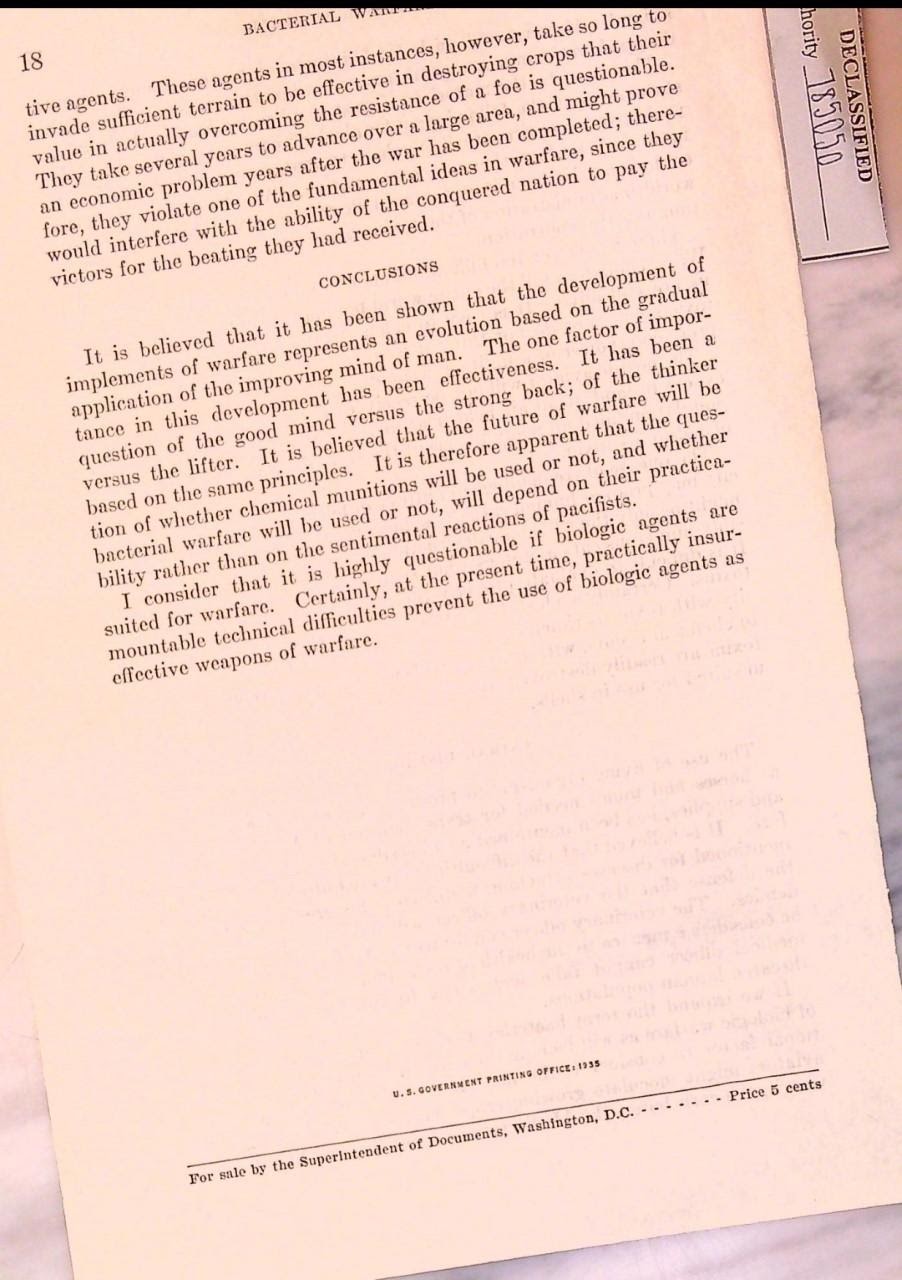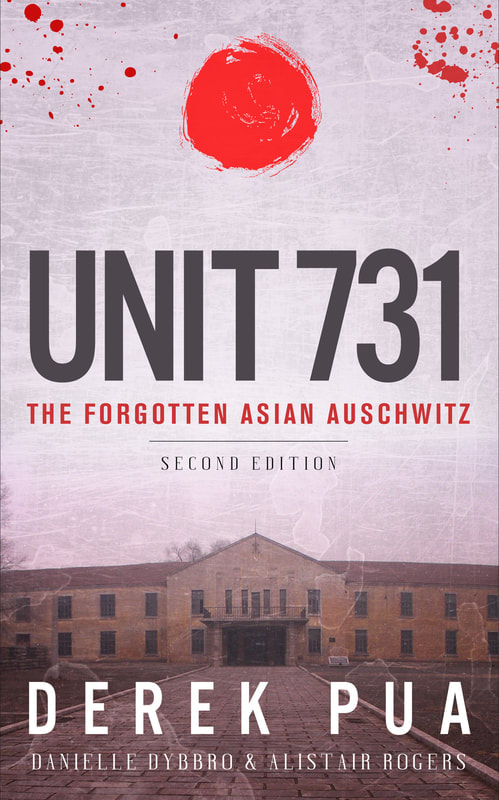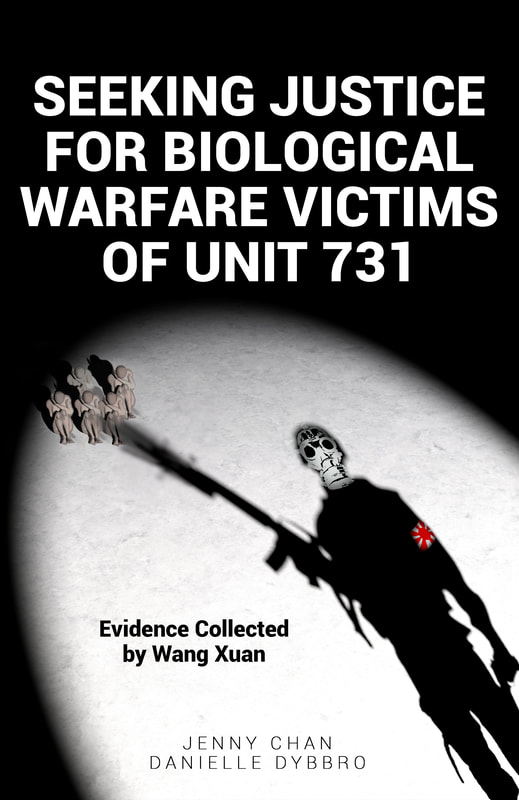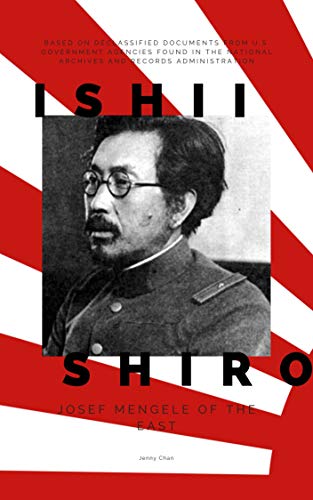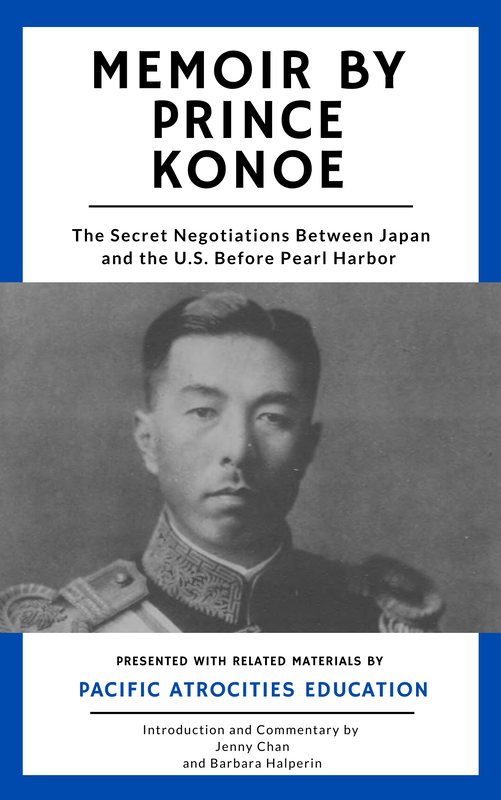|
by Merja Pyykkönen
After the horrors of what chemical warfare had applied to humans in World War I, several countries took upon matters to discuss about the prohibition to use such measures in war. As one of the leading forces behind the 1925 Geneva Protocol agreement, the United States strongly opposed any usage of biological or chemical warfare. Despite the fact that the U.S. failed to ratify the agreement until the year of 1975, their negative attitude concerning chemical warfare continued all the way up to the outbreak of World War II, when it became evident that some of the participant countries of the war had begun to take measures on both biological and chemical warfare.
(continued) It seemed as the past contracts were dismissed due to the uncertain and changing shifts of allies, and especially because Nazi Germany was on its ruthless way of conquering world dominance. Before of the outbreak of another war, the U.S. did not load much of attention into the outlines of BW and CW. With that said, the United States highly believed that investing in the preventative side would effectively eliminate future threats of BW.
This belief of safety was already expressed in 1933 by Major Leon A. Fox from the U.S. Army Medical Corps. His writing composed of disbelief into the offensive, successful use of biological warfare, a statement that did have a far-reaching impact on U.S. authorities’ skepticism towards any productive BW research conducted by other countries. The opinion continued to be cited at until 1942 until the safety blanket U.S. upheld had to be dismissed: Reports of both German and Japan activity of BW begin to surface more frequently to be overhauled anymore. Taking a bit deeper look into the pre-war judgments U.S. made, back in 1935 a U.S. source denied that some of the most dangerous infections such as tetanus, gas gangrene, and anthrax, would have very little survival rate if they would be distributed from above. Noting that if enemy planes could fly over an area and drop shells containing infections, it could only have somehow poor success. Moreover, it was acknowledged that bacteria could have better chances of offensive biological warfare when dropped out of an enemy plane or inserted in food, crops, or animals. However, U.S. did not consider any enemy planes or troops could easily enter the Unites States air space — such an idea was ridiculous, hence they did not consider the airborne spread of infections or bacteria as useful weapons. Somehow the U.S. also evaluated, that because of the presumed warmth inside of a shell, any bacterial toxins would automatically be destroyed already inside of its carrier. It can be viewed that the U.S. government and personnel thought of an automatic explosion of a contaminated shell to reach better placement of bacteria into the desired area. This heat of an explosion would then destroy its own cargo. Needless to say, that since the U.S. itself did not participate on serious BW research until the 1940s, the theory of an automatic explosion of the contaminated shell was built upon no knowledge and an assumption — one that suggested there to be only one option of spreading bacteria and infections out of air.
A threat of infected live animals among the U.S. military forces was to be eliminated by simply executing the animals if any cases would be detected. The enemy spread of bacteria and pests into the crops, in that way attempting to interfere with one’s food production, is additionally diminished hereby: An explanation that such “agents” of pests would ultimately take years to successfully contaminate large areas was established to squash the horror-like pictures of spoiled food and future famines. No harm could be reached since the presumption lied upon the slow progression of pests that could ruin the growing crops. As further Japanese field tests had proved, the spread of anthrax and glanders into crops and nature caused almost immediate exposure to extreme damages on human skin, flesh, and ultimately, bones. No animal-contaminated food was needed to be eaten to receive casualties of death and despair in the civilian population in some of the villages in China, which were the testing sites for Japanese. Similar results, therefore, could have been gotten if such was to be applied to the surroundings of military groups — it was something that avoiding obvious food crops or simply killing of an animal could not prevent.
Possessing the image of a strong U.S. military protection was, according to the writer, one to determine the utmost failure of any attempts of biological warfare that an enemy could present against it. It was contemplated although not expressed directly, that U.S. would win intellectual scientists of biological warfare because of its mighty technical power. Overall, any methodology of spreading infections and bacteria such as shells or pests was looked upon as non-believable and insufficient. Those could not even have the grounds to flourish in, because U.S. would not allow such to happen.
In this way, it appears that United States during the pre-war time (1930’s) was not only in any awareness of the circumstances taking place across the North Pacific Ocean, but also held itself invulnerable to any external threats of the use of biological warfare. As a weapon of war, biological warfare was not conceived as replacing other military equipment and technology. This conception, however, was not similar to the Japanese who by 1935 had already invested government funds on BW research and conducted experiments. The received results on humans, animals, and presumably on crops, were seen highly promising for the Japanese use of warfare.
Sources
https://2009-2017.state.gov/t/isn/4784.htm#treaty National Archives and Records Administration. Box 6 (6) p. 37-39 Lee, Nancy. “Introduction to Wang Xuan” in Seeking Justice for Biological Warfare Victims of Unit 731, 2020. Jeans Jr., Roger B. “Alarm in Washington: A Wartime ‘Exposé’ of Japan’s Biological Warfare Program.” Journal of Military History, vol. 71, no. 2, Apr. 2007, pp. 411–439. EBSCOhost, doi:10.1353/jmh.2007.0126. Related Books
0 Comments
Leave a Reply. |
- Home
- Stories
-
Internship
- Summer 2024 Internship
- Summer 2023 Internship
- Fall 2022 Internship
- Summer 2022 Internship
- Summer 2021 Internship
- Fall 2020- Spring 2021 Internship
- Summer 2020 Internship
- Fall 2019 Internship
- Summer 2019 Internship >
- School Year 2018-2019 Internship
- Summer 2018 Internship >
- Fall 2017 Internship
- Summer 2017 Internship >
- Books
- Archives
-
Resource Page
-
Supplementary Research Guides
>
- Unit 731 - Guide >
-
Philippines' Resistance - Guide
>
- Philippines World War II Timeline
- The Japanese Invasion & Conquest of the Philippines
- Bataan Death March
- Formation of Underground Philippines Resistance
- Supplies of the Guerrilla Fighters
- The Hukbalahap
- Hunter's ROTC
- Marking's Guerrillas
- United States Army Forces in the Philippines of Northern Luzon (USAFIP-NL)
- The Aetas
- Chinese and Filipino-Chinese Nationalist Guerrilla Units
- The Female Faces of the Philippine Guerrillas
- Rising Sun Flag - Guide >
- Pinay Guerrilleras - Guide >
- Fall of Singapore - Guide >
- Three Years and Eight Months - Guide >
- Siamese Sovereignty - Guide >
- The Khabarovsk War Crimes Trial - Guide >
- Unit 731 Cover-up : The Operation Paperclip of the East - Guide >
- Marutas of Unit 731 - Guide >
- Prince Konoe Memoir - Guide >
- Competing Empires in Burma - Guide >
- Battle of Shanghai - Guide >
- Ishi Shiro - Guide >
- Taiwan The Israel of the East - Guide >
- Seeking Justice for Biological Warfare Victims of Unit 731 - Guide >
- Rice and Revolution - Guide >
- Clash of Empires - Guide >
-
Hunger for Power and Self-SufficiencyI - Guide
>
- The Influence of War Rations on Post-War Culinary Transformations
- How World War II Complicated Food Scarcity and Invention
- American Military Innovations
- Government-Sponsored Food Inventions in Europe during World War II
- Feeding the Army: The Adaptation of Japanese Military Cuisine and Its Impact on the Philippines
- Mixed Dishes: Culinary Innovations Driven by Necessity and Food Scarcity
-
Denial A Quick Look of History of Comfort Women and Present Days’ Complication - Guide
>
- The Comfort Women System and the Fight for Recognition
- The Role of Activism and International Pressure
- The Controversy over Japanese History Textbooks
- The Sonyŏsang Statue and the Symbolism of Public Memorials
- Activism and Support from Japanese Citizens
- The Future of Comfort Women Memorials and Education
- Echoes of Empire: The Power of Japanese Propaganda - Guide >
- Lesson Plans >
-
Supplementary Research Guides
>
|
Pacific Atrocities Education
730 Commercial Street San Francisco, CA 94108 415-988-9889 |
Copyright © 2021 Pacific Atrocities Education.
We are a registered 501 (c)(3) charity. |
- Home
- Stories
-
Internship
- Summer 2024 Internship
- Summer 2023 Internship
- Fall 2022 Internship
- Summer 2022 Internship
- Summer 2021 Internship
- Fall 2020- Spring 2021 Internship
- Summer 2020 Internship
- Fall 2019 Internship
- Summer 2019 Internship >
- School Year 2018-2019 Internship
- Summer 2018 Internship >
- Fall 2017 Internship
- Summer 2017 Internship >
- Books
- Archives
-
Resource Page
-
Supplementary Research Guides
>
- Unit 731 - Guide >
-
Philippines' Resistance - Guide
>
- Philippines World War II Timeline
- The Japanese Invasion & Conquest of the Philippines
- Bataan Death March
- Formation of Underground Philippines Resistance
- Supplies of the Guerrilla Fighters
- The Hukbalahap
- Hunter's ROTC
- Marking's Guerrillas
- United States Army Forces in the Philippines of Northern Luzon (USAFIP-NL)
- The Aetas
- Chinese and Filipino-Chinese Nationalist Guerrilla Units
- The Female Faces of the Philippine Guerrillas
- Rising Sun Flag - Guide >
- Pinay Guerrilleras - Guide >
- Fall of Singapore - Guide >
- Three Years and Eight Months - Guide >
- Siamese Sovereignty - Guide >
- The Khabarovsk War Crimes Trial - Guide >
- Unit 731 Cover-up : The Operation Paperclip of the East - Guide >
- Marutas of Unit 731 - Guide >
- Prince Konoe Memoir - Guide >
- Competing Empires in Burma - Guide >
- Battle of Shanghai - Guide >
- Ishi Shiro - Guide >
- Taiwan The Israel of the East - Guide >
- Seeking Justice for Biological Warfare Victims of Unit 731 - Guide >
- Rice and Revolution - Guide >
- Clash of Empires - Guide >
-
Hunger for Power and Self-SufficiencyI - Guide
>
- The Influence of War Rations on Post-War Culinary Transformations
- How World War II Complicated Food Scarcity and Invention
- American Military Innovations
- Government-Sponsored Food Inventions in Europe during World War II
- Feeding the Army: The Adaptation of Japanese Military Cuisine and Its Impact on the Philippines
- Mixed Dishes: Culinary Innovations Driven by Necessity and Food Scarcity
-
Denial A Quick Look of History of Comfort Women and Present Days’ Complication - Guide
>
- The Comfort Women System and the Fight for Recognition
- The Role of Activism and International Pressure
- The Controversy over Japanese History Textbooks
- The Sonyŏsang Statue and the Symbolism of Public Memorials
- Activism and Support from Japanese Citizens
- The Future of Comfort Women Memorials and Education
- Echoes of Empire: The Power of Japanese Propaganda - Guide >
- Lesson Plans >
-
Supplementary Research Guides
>
